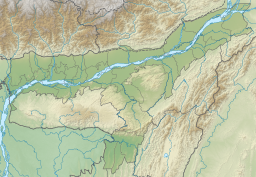| Dipor Bil or Deepor Beel | |
|---|---|
 | |
| Location | Guwahati, Kamrup district, Assam |
| Coordinates | 26°08′N 91°40′E / 26.13°N 91.66°E |
| Type | Fresh water |
| Basin countries | India |
| Surface area | 4,014 ha (15.50 sq mi) |
| Average depth | 1 m (3.3 ft) |
| Max. depth | 4 m (13 ft) |
| Surface elevation | 53 m (174 ft) |
| Settlements | Twelve villages on the periphery of the beel |
| Website | www |
| Official name | Deepor Beel |
| Designated | 19 August 2002 |
| Reference no. | 1207[1] |
Dipor Bil, also spelled Deepor Beel (Pron: dɪpɔ:(r) bɪl) (bil or beel means "lake" in the local Assamese language), is located to the south-west of Guwahati city, in Kamrup Metropolitan district[2] of Assam, India.[3] It is a permanent freshwater lake, in a former channel of the Brahmaputra River, to the south of the main river. In 1989, 4.1 km² of the area was declared a wildlife sanctuary by the Government of Assam. It is listed as a wetland under the Ramsar Convention which designated the lake as a Ramsar Site in November 2002 for undertaking conservation measures on the basis of its biological and environmental importance.[3][4]
Considered one of the largest beels in the Brahmaputra valley of Lower Assam, it is categorised as representative of the wetland type under the Burma monsoon forest biogeographic region.[5]
The Dipor Bil is reported to provide, directly or indirectly, its natural resources for the livelihood of fourteen indigenous villages (1,200 families) located in its precincts.[6] Freshwater fish is a vital source of protein and income for these communities; the health of these people is stated to be directly dependent on the health of this wetland ecosystem. A member of Deepor Beel Fishermen's Cooperative Society has succinctly stated:[6] "Our forefathers protected this wetland and we are committed to do the same as we depend on the wetland for our livelihood. We will protect this wetland at any cost and against any odds".
- ^ "Deepor Beel". Ramsar Sites Information Service. Retrieved 25 April 2018.
- ^ "BirdLife Data Zone".
- ^ a b "Ramsar Wetlands Information Sheet — Deepor Beel" (PDF). Ramsar Convention on Wetlands official website. Archived from the original (PDF) on 27 September 2007. Retrieved 27 June 2007.
- ^ Ramsor sites Archived 2008-10-15 at the Wayback Machine
- ^ http://envfor.nic.in/divisions/csurv/Wetland%20Inventory.pdf Archived 3 March 2016 at the Wayback Machine Wet Land Inventory.pdf, Deepor Beel, pages 195–202
- ^ a b http://www.globalresponse.org/gra.php?i=1/08 Archived 2010-07-10 at the Wayback Machine Protect Wetland Bird Paradise/India
